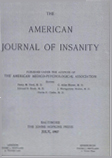REPORT OF RESEARCH AND EXPERIMENTATION IN EXERCISE AND RECREATIONAL THERAPY
Abstract
In conclusion, the writers do not wish to create the impression that physical therapy has been viewed as a panacea. Its many limitations, both as to content and methods have been apparent in attempts to utilize many and diversified activities nor has physical therapy been employed at this Facility as a purely independent adjuvant. The ideal therapeutic program advocated and carried out has represented a balanced regimen of work, rest and recreation. Attempts are constantly being made to impress patients with the importance of progressing from play activity to the more responsible role typified by work so that they may be assisted in their return to normal responsibility. The importance of utilizing play mechanisms as a distinctive means of elevating the patient's social respect in the direction of more easeful and confident social relationships, which will assist the individual to resume his place in normal society, is being constantly stressed. The physical program has been organized so as to fit most effectively and cooperatively into the regular hospital routine. It is hoped that these observations may lead to further study of the possibilities of this adjuvant in the promotion of more effective rehabilitative methods.
Access content
To read the fulltext, please use one of the options below to sign in or purchase access.- Personal login
- Institutional Login
- Sign in via OpenAthens
- Register for access
-
Please login/register if you wish to pair your device and check access availability.
Not a subscriber?
PsychiatryOnline subscription options offer access to the DSM-5 library, books, journals, CME, and patient resources. This all-in-one virtual library provides psychiatrists and mental health professionals with key resources for diagnosis, treatment, research, and professional development.
Need more help? PsychiatryOnline Customer Service may be reached by emailing [email protected] or by calling 800-368-5777 (in the U.S.) or 703-907-7322 (outside the U.S.).



